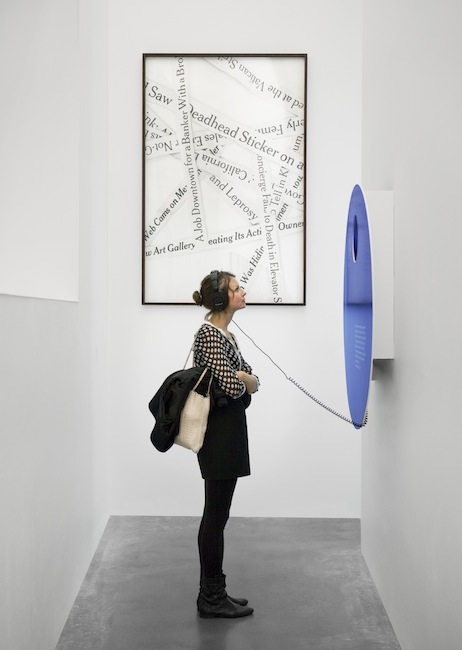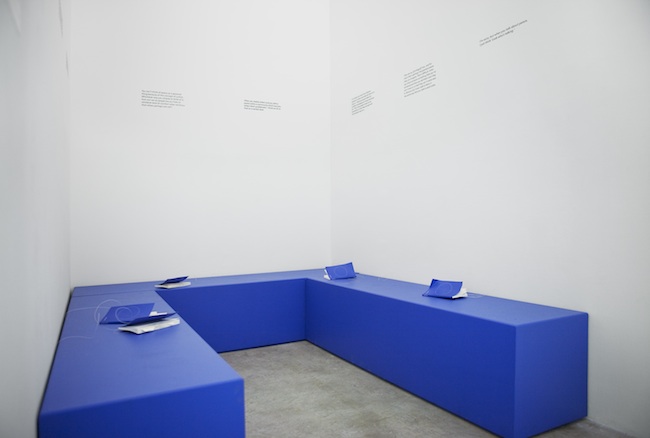
The Perpetual Peace Project
By Aaron Levy, executive director and chief curator of the Slought Foundation
For the last few months, I have had the pleasure of working out of the New Museum of Contemporary Art in downtown New York. My “office” is not to be found amongst administration on the 6th floor, however; nor will you find me listed in any staff directory. Instead I work out of a large blue circle on the fourth floor, associated with the Perpetual Peace Project, an initiative that seeks to create forums in which to reflect on what peace means to each of us. From workshops with students in Pakistan and China, to symposia with heads of state at the United Nations, our project has produced a variety of such forums over the past two years. Our partners on the project include political, cultural, and non-governmental organizations ranging from the International Peace Institute, to the European Union, and the Syracuse University Humanities Center–each of whom have been asked to commit not their money but their ears, their willingness to be fundamentally implicated by other’s ideas. They represent an informal network, one that seeks to go beyond typical definitions of “collaboration” and recognizes that today we simply cannot keep aestheticizing culture, divorcing it from its political consequences and responsibilities.
Our circle at the New Museum is one such forum, and over the last few weeks it has been animated and redefined by many voices and conversations–some organized by my colleagues and I back here in Philadelphia at Slought Foundation, others by the museum itself, yet others self-organized by those passing through. Artists and philosophers, diplomats and statesmen, students from high-risk schools in the area–all have engaged each other and the public passing by in conversation, sharing with those assembled their perspectives and views. It’s a cosmopolitan space, the kind of space that there ought to be more of.
Our project at the museum is one part of The Last Newspaper, a larger exhibition there that highlights the ways that organizations throughout the United States such as ours are reinvigorating and upholding the idea of public discourse, at a time when meaningful forums (such as newspapers), are being altogether dismantled and rendered corporate. Of course the severity of the problem–the demise of public spaces for meaningful discourse and debate–has intensified over decades, and is more than any one organization can presume to solve. What we can do, however, is to mitigate the situation, one person at a time, and to experiment, in the ways that cultural organizations are so good at doing–as we are trying to do at the New Museum–by exploring and testing other models. In the remaining space of this blog post I’d like to briefly share with you some of our findings, which I think are emblematic of the times, and a bit more on our project too.
As a curator, I feel that one of our most urgent tasks today in the cultural sector is to understand the sea-change taking place around us in how creativity is defined and understood–but also, more problematically, the loss of trust that many on the street have developed with cultural and political institutions in general. Our collective task is to enable a fundamentally different and more egalitarian approach to emerge, one that resists theatricalizing display, resists the commoditization of cultural work, and aspires to be fundamentally responsive and inclusive to the communities of which we are a part. We must think not in terms of exhibitions, but initiatives–our task is to launch not productions but processes, without worrying where they will end. Art is, after all, not about artifacts as much as it is about social relationships, and it is in fidelity to that notion that we need to reclaim, through seemingly minimal gestures, spaces for dialogue, interaction, and reflection in our civic institutions, with the hope of enabling new forms of community, but also new forms of institutions, to emerge.
At the New Museum, we have sought to be welcoming and hospitable–but not necessarily in a loud way, for instance with curatorial text or placards. Rather, we perform it, beginning with the aforementioned blue circle for conversation. Hidden away in a small stairwell gallery, visitors to the museum also encounter an intimate reading room; scattered throughout the building in ancillary spaces including the lobby, stairwells, and hallways, visitors are further invited to think anew about geopolitical conflict–their relationship to the larger developments taking place today in the world, their own responsibilities and complicities–by viewing selections from a film we have been producing joining philosophers and statesmen in conversation. Museums have, for far too long, been seen as spaces of theatricality and performance, spaces that are supposed to on some level entertain. Perhaps museums can be more than that, and can invite their publics to think and engage with the world around them–to be implicated by other voices and perspectives.
But it is in keeping with the project’s vision, of probing and exploring the possibilities and limitations of dialogue, to also ask critical questions not just about peace but also about the possibility of public conversation more generally. In the context of a museum, for instance, or in the context of this blog, can we meaningfully communicate the ideas and perspectives of others who are often unheard? How can we be truly implicated, in other words, while in a museum in New York, by the perspective of someone in Beijing or Lahore, Tijuana or Rwanda? My point is not to romanticize our cultural differences but to highlight the fact that today, despite the globalization of society, our cultural differences are many and multiplying. To what degree can our realities, or even concepts such as peace, be translated across these borders? While organizing a project a few years back for the US Pavilion at the Venice Biennale, I noticed that an average length of time for most visitors to the exhibition was around 5 minutes. To what degree can a curator or a cultural institution truly welcome a public in, or enact meaningful change, working with circumstances such as these?
Perhaps it is worth noting what Ed Luck, a special advisor to United Nations Secretary-General Ban Ki-moon, suggested when we were filming him. He noted that the cultural and non-governmental sector tends to define change in terms of days or months, as something that we ourselves want to be there to witness. One of his current responsibilities includes overseeing and advising the United Nation’s Responsibility to Protect initiative, which calls for nations to be responsible not to its citizens but to people, regardless of nationality. He explained that in his work, he doesn’t have the luxury of thinking in that way. Rather, he approaches change on a different temporal register–as something that takes place not on the level of days, or weeks, or even years, but rather on the level of decades. If one takes that perspective, well, perhaps there is reason to be hopeful indeed.
Aaron Levy is the Executive Director and Chief Curator of the Slought Foundation, a Philadelphia-based experimental institution. For more information about the Perpetual Peace Project, please visit: http://perpetualpeaceproject.org For more information about Slought Foundation: http://Sloughtfoundation.org
Recent Content
-
Artsarticle ·
-
Artsarticle ·
-
Artsarticle ·



